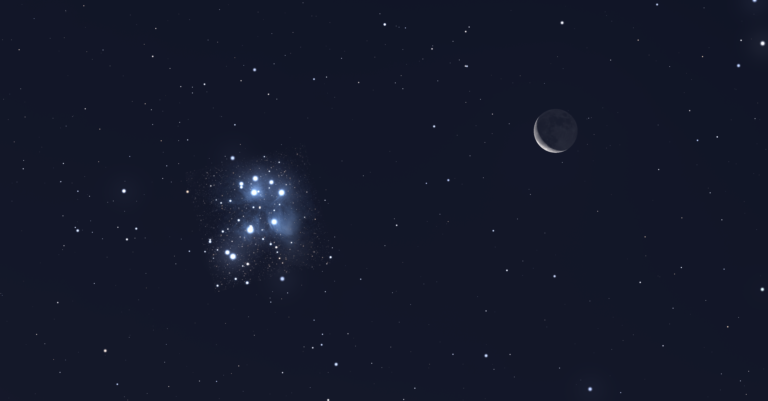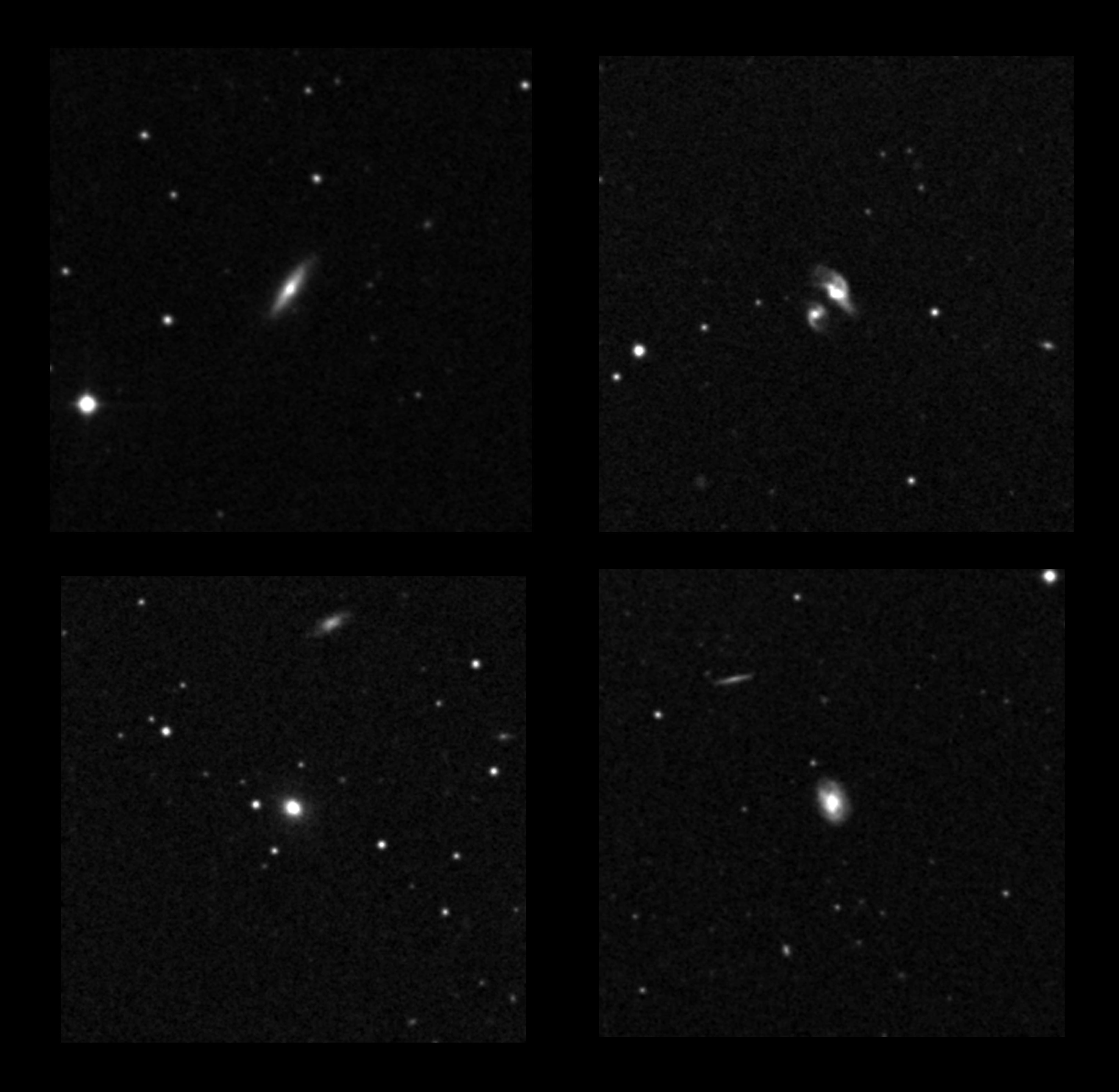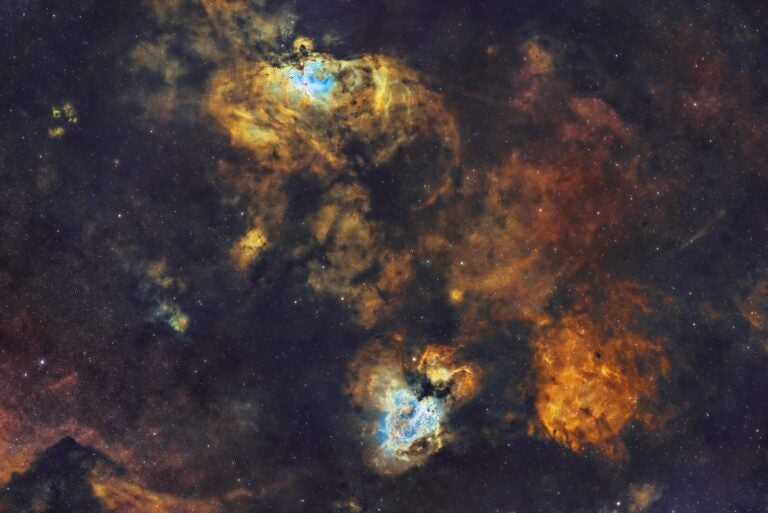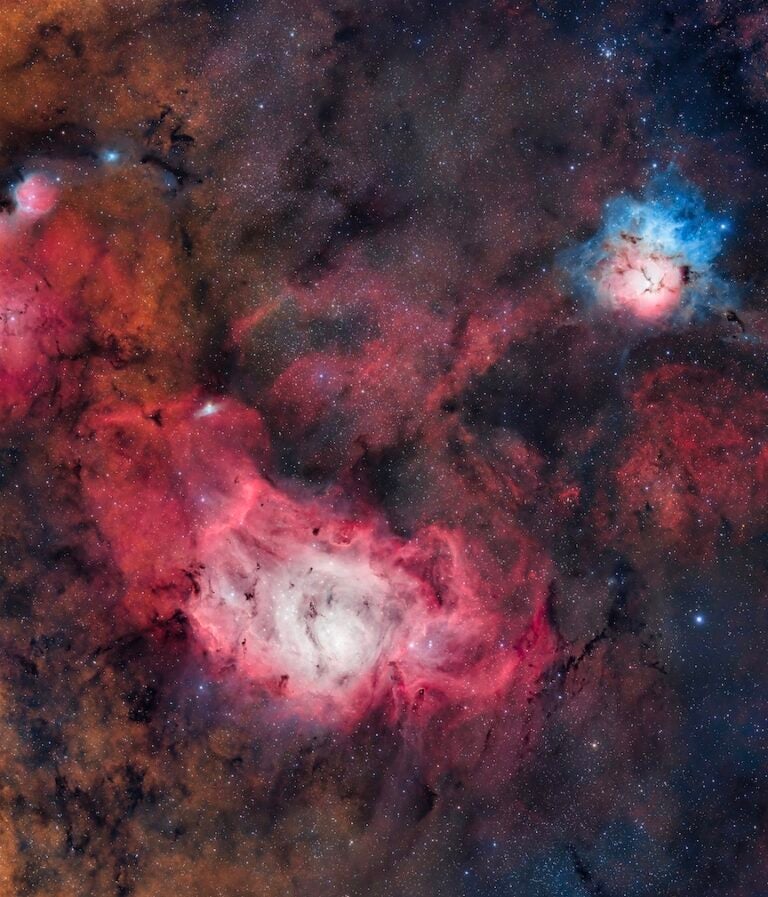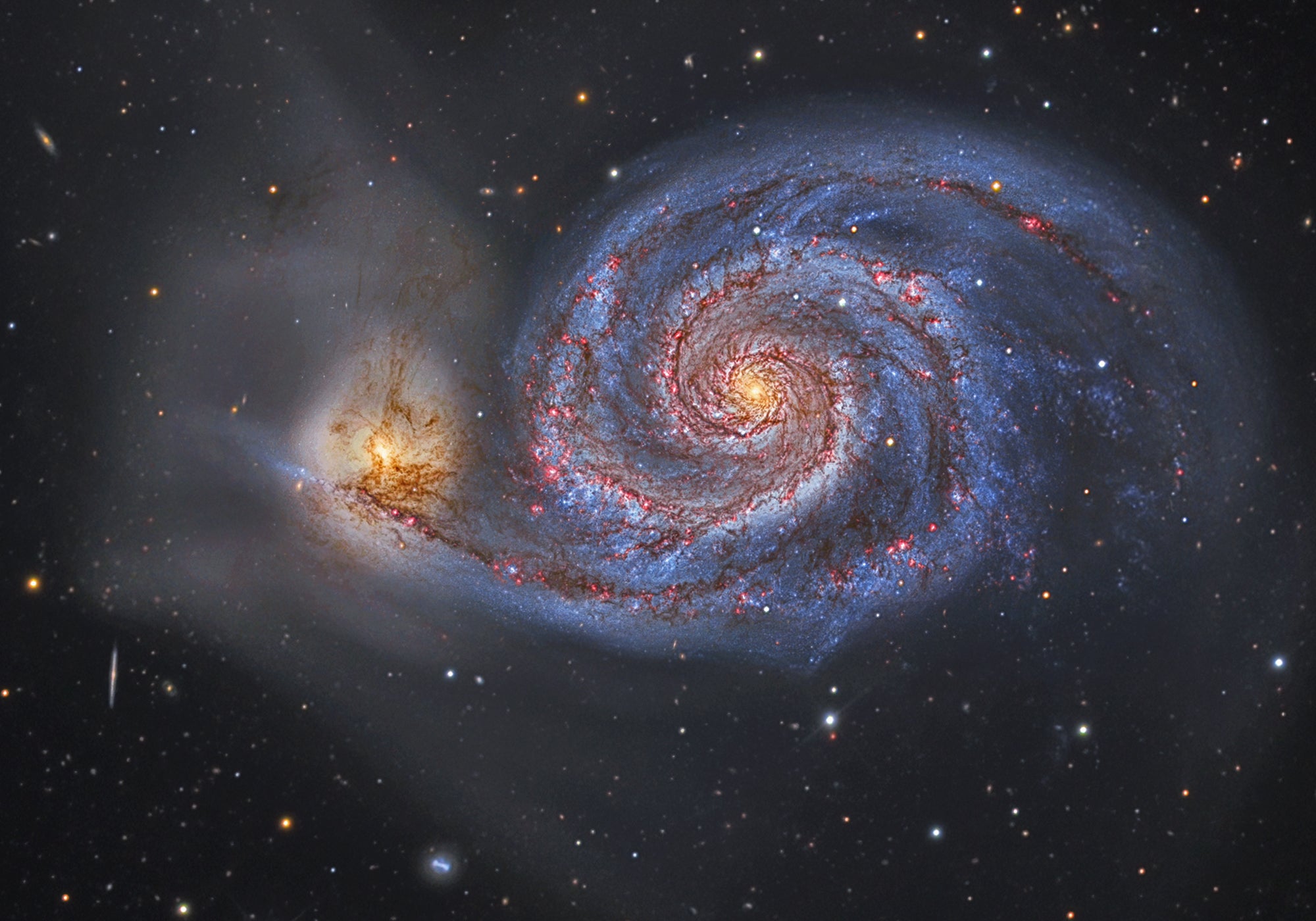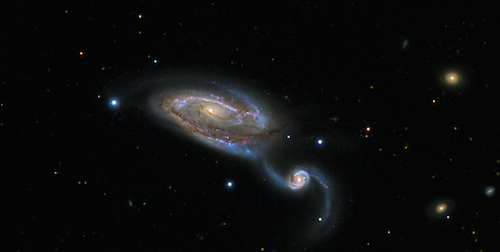
Open clusters
Robert Trumpler studied open star clusters in the early 20th century to learn their distances, sizes, and distribution in the Milky Way. He investigated 100 clusters, 37 of which were unknown at the time and eventually became the Trumpler catalog. Although most of these clusters tend to be overlooked, a few are true gems.Trumpler 2 is a scattering of 20 stars about 2.5° southeast of the Double Cluster in Perseus. This small collection glows at 6th magnitude across a distance of more than 2,000 light-years. Its brightest member is the orange star SAO 23469.Trumpler 3 lies 8.6° east of the 3rd-magnitude star Epsilon (ε) Cassiopeiae. At first glance, it shows about 30 stars in a 23′ field, but astronomers have discovered some 570 members in total. Researchers estimate the 7th-magnitude cluster formed only about 70 million years ago, during Earth’s Late Cretaceous period.Trumpler 5 resides just west of the Cone Nebula (part of the NGC 2264 complex) in Monoceros. This rich cluster contains some 150 stars packed in an area 7′ across, but the 11th-magnitude object glows faintly enough that you’ll need large optics for a good view. This ancient cluster lies in the direction opposite to our galaxy’s center and appears to be between 3 billion and 4 billion years old.Peculiar galaxiesHalton Arp’s famous 1966 Atlas of Peculiar Galaxies remains a favorite of deep-sky observers. Many of the catalog’s 338 objects are bright (a few are Messier objects), while others pose a challenge for big apertures. Although Arp considered these galaxies peculiar for the way they looked, astronomers now realize most are interacting or colliding galaxies. As such, they often look intriguing through a telescope.Arp 157 (NGC 520) ranks among the more unusual objects in Pisces. This edge-on pair of colliding galaxies looks like a triangular door wedge. Glowing at magnitude 11.4 and measuring 4.6′ by 1.7′, the object shows up through 8-inch scopes.Arp 22 (NGC 4027) is a barred spiral galaxy with a single extended arm that looks like a comma through amateur telescopes — definitely not a typical spiral! This 11th-magnitude denizen of Corvus spans 3.8′ by 2.3′. Its strange appearance likely arises from a collision with a smaller galaxy millions of years ago.Galaxy clusters
Abell’s catalog of rich galaxy clusters initially contained 2,712 entries. After Abell died in 1983, Harold Corwin and Ronald Olowin continued the survey in the southern sky. They added 1,361 clusters, bringing the total to 4,073.Abell 262 glows at 13th magnitude and is one of several galaxy clusters in Andromeda visible through modest telescopes. It holds seven NGC objects and dozens of fainter galaxies in a compact field. Unlike most rich galaxy clusters, Abell 262 has a high percentage of spirals. It belongs to the enormous Perseus-Pisces Supercluster, which includes the Perseus Cluster (Abell 426).Abell 1367, the Leo Cluster, dwells 5.5° north of 2nd-magnitude Denebola. The brightest cluster member, the magnitude 11.8 elliptical galaxy NGC 3842, possesses a central black hole with a mass of nearly 10 billion Suns, making it one of the most massive black holes known. This spiral-rich cluster appears more than three times the diameter of the Full Moon, so you’ll want to use a wide-field eyepiece to explore it. Many of the targets glow brighter than 13th magnitude; the challenge comes in identifying each object.
Palomar globular clustersAlthough Abell created this list, several other astronomers helped find these
globulars on the POSS plates, and
Helen Sawyer Hogg probably deserves the credit for giving them the “Palomar” name. Thirteen of these 15 clusters were unknown to astronomers of the mid-1950s. They are not easy to observe because they have low surface brightnesses, and interstellar matter obscures many of them. The three targets I’ll highlight are among the toughest objects in this article. Seek them under the most transparent skies you can get.Palomar 6 rates as one of Ophiuchus’ most challenging clusters. Embedded in a rich star field on the constellation’s border with Sagittarius, Palomar 6 is large (7.2′ across), faint (magnitude 11.6), and diffuse. It is one of four globulars known to harbor a planetary nebula, a 16th-magnitude object that spans 8″ on the cluster’s north side.Palomar 8 in Sagittarius shines at magnitude 11.0, making it one of the list’s brighter clusters. A round glow measuring 4.7′ across, Palomar 8 lies 2.4° east-southeast of the bright open cluster M25.Palomar 11 lies 2.3° east-southeast of 5th-magnitude Kappa (κ) Aquilae. Although Palomar 11 glows at 10th magnitude, that’s deceptive because its light is spread over a diameter of nearly 10′.I hope this article entices you to explore the tip of an astronomical iceberg. You can find plenty more specialized catalogs online. Look for names like Collinder, Hickson, Sharpless, and Terzian — these are just a few that await discovery as you expand your universe.Arp 214 (NGC 3718) lies 3.2° west of Gamma (γ) Ursae Majoris. A distorted spiral with a large dust lane arcing across the middle of the disk, Arp 214 combines features of a face-on and edge-on galaxy. Shining at magnitude 10.7 and measuring 10′ by 4.7′, it is large and easy to observe. NGC 3729 is a smaller spiral to the east that likely collided with NGC 3718. Arp 322, a complex group of galaxies also cataloged as Hickson 56, lies 7′ south of Arp 214 and in the same field of view.
Arp 84 (NGC 5394-5) is a wonderful pair of interacting galaxies often overlooked in favor of its neighbor in Canes Venatici, the Whirlpool Galaxy (M51, Arp 85). Arp 84 is visible through modest telescopes, though larger apertures reveal more detail. NGC 5394 is a magnitude 13.0 compact spiral measuring 1.7′ by 0.7′ with two faint, elongated arms. Glowing at magnitude 11.7, NGC 5395 is bigger (2.7′ by 1.2′) and has one arm sweeping in front of its disk.
George Abell:
master list creatorCaltech graduate student George Abell was among the first people to study the POSS plates after they were developed. As a result, he had first dibs on looking for new objects. His efforts produced three lists of different objects: planetary nebulae, globular star clusters, and galaxy clusters. He published the first two in 1955; the 1957 galaxy cluster catalog served as his Ph.D. thesis.
Planetary nebulaeAbell 12 is the easiest of the Abell planetaries to find because it lies just 1.2′ west-northwest of 4th-magnitude Mu (μ) Orionis. Like all low-surface-brightness planetary nebulae, an Oxygen-III filter increases its contrast with the background sky and makes it easier to see. This Sun-like star’s death shroud spans 40″.Abell 21, better known as the Medusa Nebula, resides in southern Gemini near the constellation’s border with Canis Minor. This crescent-shaped nebula measures about 10′ by 6′, which translates into a physical diameter of 4 light-years, placing Abell 21 among the oldest known planetaries.Abell 39 in Hercules is a ghostly cloud of ionized gas in the shape of an almost perfect circle spanning 2.6′. Like many Abell planetaries, it is a challenge, but observers with an 8-inch scope under a dark sky can see it.Ever since humans first looked up at the night sky, they have felt compelled to record what they saw. The Babylonians of Mesopotamia compiled the first known star catalog more than 3,100 years ago, and other ancient civilizations followed with their own star catalogs. All were limited to what the naked eye could see.The telescope’s debut 400 years ago revealed objects invisible to the naked eye. As the universe began to unfold, astronomers developed new catalogs to record their observations.
In the 18th century, French comet-hunter Charles Messier created the first account of deep-sky objects that included both locations and descriptions. He did it to avoid “rediscovering” previously observed faux comets. His list soon became the catalog of choice for amateur astronomers because the clusters, nebulae, and galaxies it contains are bright and varied. The objects also covered most of the sky visible from mid-northern latitudes.In 1888, Danish-Irish astronomer John Louis Emil Dreyer compiled the next astronomical standard: the New General Catalogue. (For a more complete story on this catalog, see “An NGC primer” in the September 2018 issue.) Based on visual observations, the NGC was the main source for non-stellar celestial objects for more than 60 years. Even today, it remains the preferred catalog for serious deep-sky observers.Photography gradually replaced the astronomer’s eye in the second half of the 19th century. And as telescopes grew up to 200 inches in aperture in the 1940s, the universe started to reveal its secrets at an astonishing rate. The National Geographic Society-Palomar Observatory Sky Survey (POSS) was the first systematic attempt to photograph the entire sky visible from a single location (California’s Palomar Mountain). Astronomers used hand lenses to study the black dots and blobs that appeared on the large photographic plates.In the second half of the 20th century, large low-cost optics became available to amateur astronomers, and fainter, more obscure objects grew popular. Observers turned to newer catalogs to tackle objects that many folks a generation earlier had thought impossible to see. Completing these catalogs became badges of honor for amateurs seeking targets that few had seen.
Many obscure catalogs have now become mainstream. Some of the objects they contain are easy, while others require large scopes and superb skies. Let’s take a look at some of my favorite examples.





